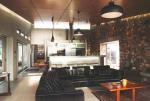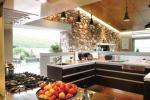Cable Bay
By Graham Hepburn
Being a Waiheke Island resident, architectural designer Bryce Ardern is well aware of the constraints and challenges of building on the island. Bryce, whose design firm Ardern UDB is based on the island, says building more sustainable homes is not just desirable on Waiheke, it is pretty much essential.
“Waiheke demands that in many ways; we’re not on town supply water and you can’t just hook up to services,” says Bryce, who has also founded a sustainable building arm to his design business – Lite-House. “You’ve got to manage your own stormwater and wastewater and we quite often have power outages on the island.”
So when it came to designing and building this Cable Bay residence – a job undertaken by Ardern UDB and Lite-House respectively - those considerations had to be taken into account as well as planning controls that meant the home had to merge with the landscape as much as possible because it was visible from the sea.
This meant cutting a building platform so the split-level home hunkered down into the landscape aided by its monopitch rooflines that were designed to mimic the contours of the site. Roofing it with Multidek® COLORSTEEL® Maxx® Sandstone Grey also helped to blend the building with the site and met the low-reflectivity values demanded by planning rules.
“It’s a logical choice to go for a longrun roof product because we can tailor it to the exact lengths we need for our roof runs,” says Bryce. “And it also makes collecting water off the roof easy.”
He adds that Multidek® COLORSTEEL® Maxx®roofing was an ideal product because it could resist corrosion by salt spray as well as handle the “high wind and rain loads” on the island.
“The weather patterns are quite extreme on Waiheke,” says Bryce. “We can get horizontal rain from the southwest.”
Paul Ross, of Roofing Industries, says the popularity of Multidek® has grown dramatically since inception because it works well as both residential and commercial roofing and cladding. “The wide tray-type 500mm profile portrays design inspiration and provides that European feel,” Paul says.
“Multidek® does not require a supporting ply substrate and utilises a hidden clip system and therefore has no fastener penetrations. It is excellent in high wind zones and areas of high-density rain fall and there is an extensive colour range available including metallics.”
Making the home part of the landscape has been taken a step further with the use of a spine wall built from Waiheke Rock – quarried at Stoney Ridge. This wall seems to emerge from the ground at the front of the house, creating a garden wall on the eastern side before gaining height and presence as part of the
home, including the chimney. The different colours of the rock are on display in this exposed wall in the open plan kitchen and living area. As Bryce says, “The very honest use of the structural materials in this home means everything is on show. Waiheke Rock and precast concrete walls with ply soffit and ceiling panels flow from the outside to inside in a simple seamless use concealing the detailed work including flashings and structural work underneath.”
In line with geotech recommendations, 4m-deep shortbore concrete piles have been used and these support header beams that in turn support the wall panels, which are a concrete-XPS polystyrene-concrete sandwich. These panels have an R value of about 3.0 and provide great thermal mass for heat storage in
winter, while moderating the interior temperature in summer. These panels go below the floor slabs to create a thermal break around them. No strapping and lining is needed, and the concrete remains exposed outside as well as inside many of the rooms. Electrical and plumbing conduits were cast into the wall
panels and connected with those under the floor, which is made up of Ribraft floor pods and concrete.
The home has been designed in four main modules around three main outdoor living areas to provide options depending on weather and season. The sea views are to the west, meaning exposure to cold southwesterly winds so rooms are grouped around a protected northern court. There is also an enclosed, glass roofed inner court that enjoys the western views and has a custom-made indoor/outdoor kitchen complete with barbecue and range hood. This room, like the rest of the house, has in-floor hydro heating and is fully insulated for year-round use.
Along with the heat pump-powered heated floor and the insulation provided by the walls, the home has R5.0 ceiling insulation and argon-filled low emissivity doubleglazed aluminium joinery. There is a woodburning fire in the living room and the solar water heating is gas boosted. The eaves of the home have been detailed so that winter sun hits the concrete floor for passive heating but the summer sun is excluded. The insulated walls and ceiling help to keep the summer heat out, while electronically controlled high-level windows provide further cooling. LED lighting also helps to cut energy usage.
The home was a national category winner, taking the Outdoor Living Award at the National Registered Master Builders 2012 House of the Year and was a category and gold medal winner in the Auckland competition. While Bryce is proud of the awards, equally satisfying is the fact that the home meets Lite-House’s ten-point sustainability plan:
- Minimise CO2 emissions by building with locally sourced products.
- Minimise energy demands with super insulation and super-efficient heating.
- Respond to the local climate by careful design and siting.
- Minimise use of materials and other resources.
- Reduce and recycle building waste.
- Collect, conserve and recycle water.
- Select materials based on recycling analysis.
- Demonstrate sustainable systems.
- Respect vernacular design and building.
- Create great architecture
Bryce said he decided to set up Lite-House in 2008 to ensure his designs were being fully implemented. “I started off in building then went away from it but I just felt we weren’t getting control of the design process and project management side of it,” he says. “Now we’ve got total control of the job, from dealing with clients to the key in the door stage.”
Ardern UDB
Established by Bryce Ardern in 2001, Ardern Unique Design and Build focuses on designing quality homes and commercial properties. Houses have been designed in a range of styles - Balinese, Italian, contemporary, French and early Kiwi styles of architecture. The company’s philosophy is based on offering a personalised approach and making the business of designing and building homes an exciting journey for everyone involved. “We are proud that our business has been built on referral from satisfied clients and that the homes we have designed have been recognised with numerous awards.” Bryce Ardern started out as a quantity surveyor before moving on to manage divisions of Fletcher Building and then qualifying as an architectural designer.





